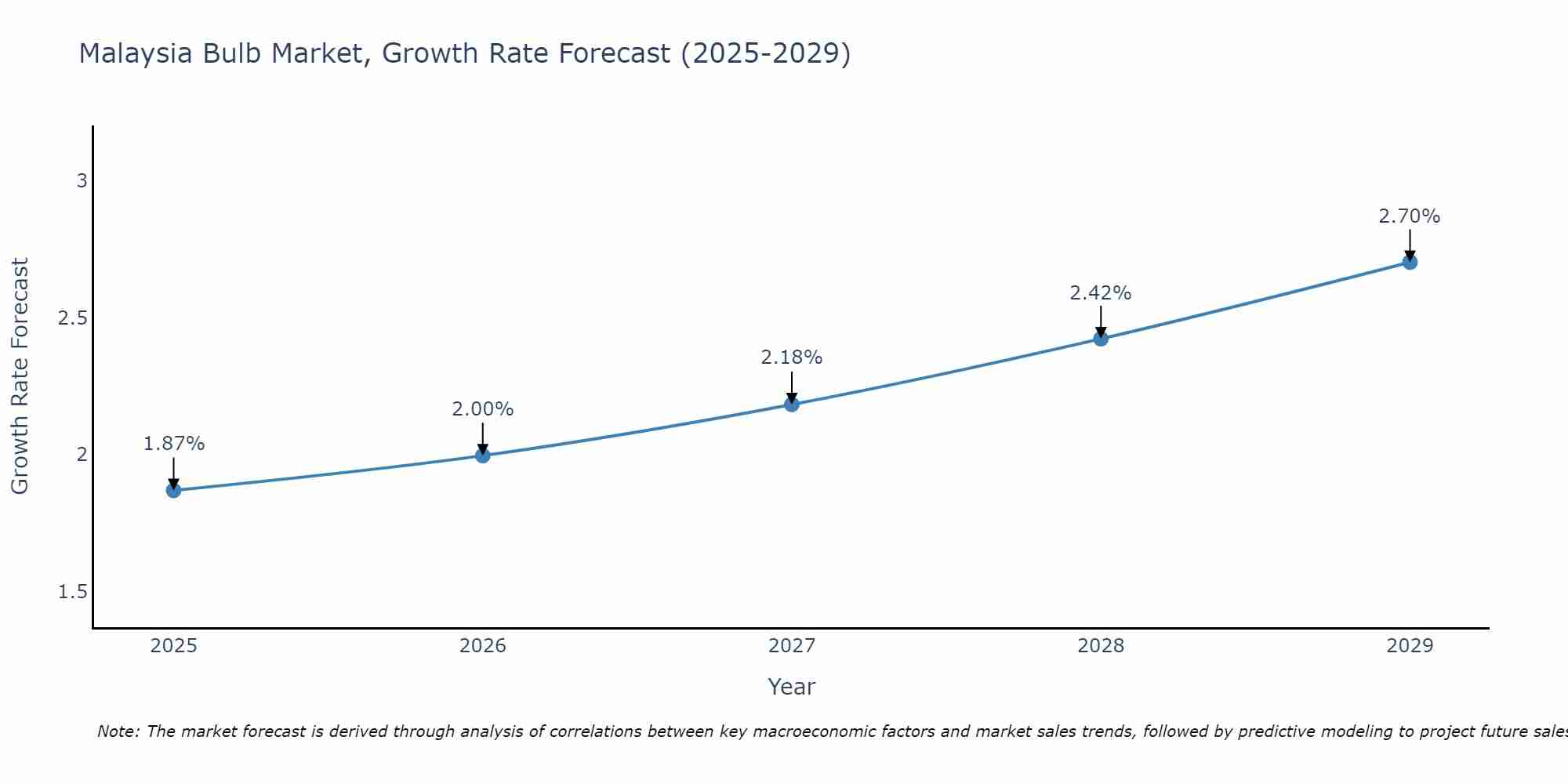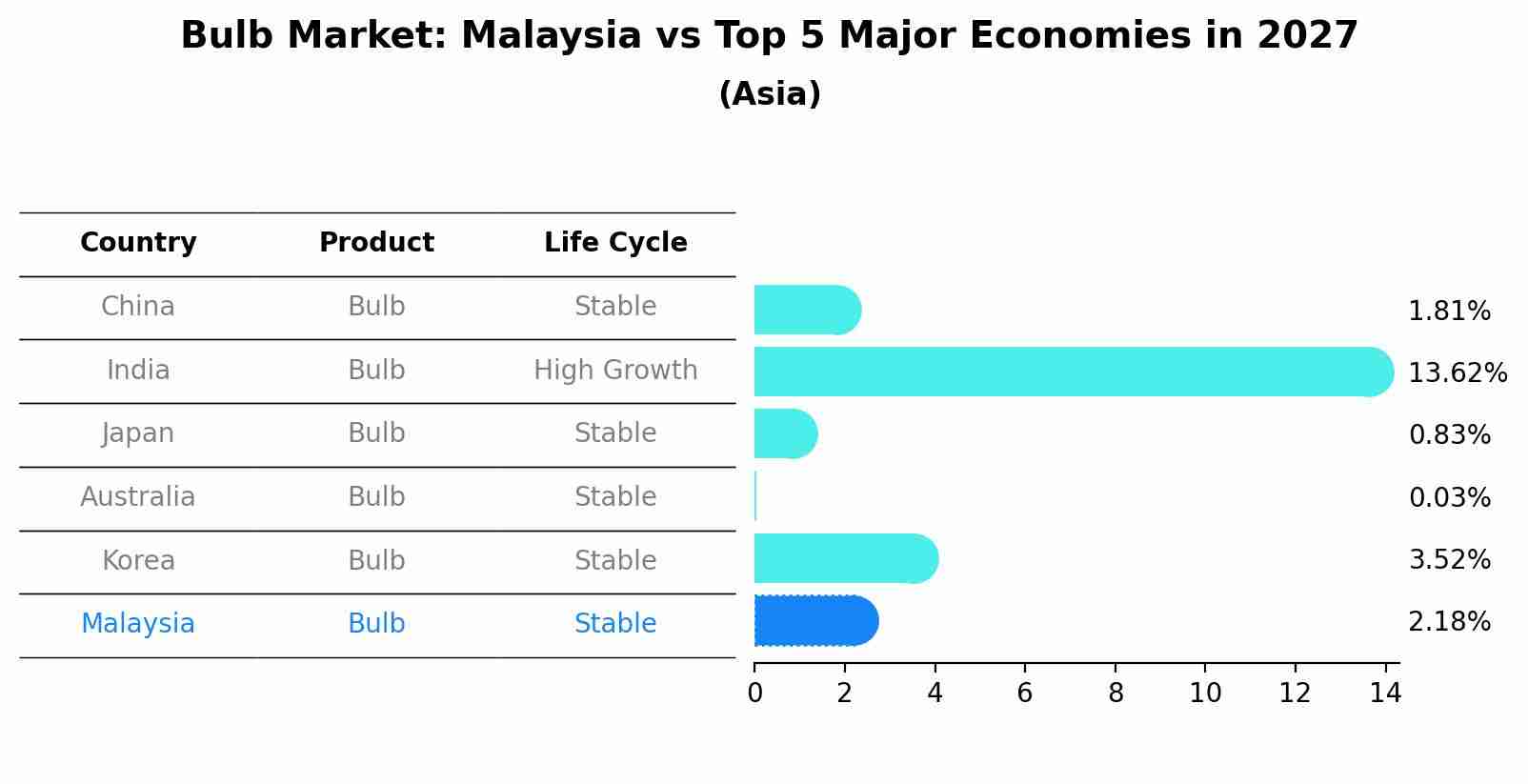Malaysia Bulb Market (2025-2031) Outlook | Revenue, Industry, Analysis, Companies, Size, Share, Growth, Forecast, Trends & Value
| Product Code: ETC258746 | Publication Date: Aug 2022 | Updated Date: Aug 2025 | Product Type: Market Research Report | |
| Publisher: 6Wresearch | No. of Pages: 75 | No. of Figures: 35 | No. of Tables: 20 | |
Malaysia Bulb Market Size Growth Rate
The Malaysia Bulb Market is likely to experience consistent growth rate gains over the period 2025 to 2029. Commencing at 1.87% in 2025, growth builds up to 2.70% by 2029.

Bulb Market: Malaysia vs Top 5 Major Economies in 2027 (Asia)
The Bulb market in Malaysia is projected to grow at a stable growth rate of 2.18% by 2027, within the Asia region led by China, along with other countries like India, Japan, Australia and South Korea, collectively shaping a dynamic and evolving market environment driven by innovation and increasing adoption of emerging technologies.

Malaysia Bulb Market Synopsis
The Malaysia bulb market has been undergoing significant changes due to the global transition towards energy-efficient lighting solutions. Traditional incandescent bulbs are gradually being phased out in favor of LED and CFL bulbs, driven by energy-saving initiatives and environmental concerns. Consumers are becoming more conscious of their energy consumption, resulting in a shift towards eco-friendly lighting options. The market outlook for bulbs in Malaysia is characterized by the continued adoption of energy-efficient technologies, with LED bulbs dominating the market share.
Drivers of the Market
The Malaysia bulb market is undergoing a transformation driven by energy efficiency concerns and environmental awareness. Traditional incandescent bulbs are being phased out in favor of more energy-efficient options like LED bulbs. Government regulations and consumer preferences for long-lasting and energy-efficient lighting solutions are driving the shift towards LED bulbs, which is expected to dominate the market.
Challenges of the Market
The Malaysia bulb market faces challenges associated with energy efficiency and environmental sustainability. Consumers are increasingly inclined towards energy-efficient LED bulbs, posing a challenge for traditional incandescent and fluorescent bulb manufacturers. Adhering to energy efficiency standards and labels becomes crucial. Additionally, ensuring product quality and longevity to maintain consumer trust is essential. Environmental concerns, such as proper disposal and recycling of bulbs containing hazardous materials, also require attention. Balancing cost-effectiveness with sustainability and regulatory compliance is key for manufacturers and sellers in this market.
COVID 19 Impact on the Market
The bulb market faced shifts in consumer preferences during the pandemic. As more people spent time at home, there was a heightened focus on energy-efficient lighting solutions. LED bulbs gained popularity due to their efficiency and longevity. The post-pandemic market is expected to prioritize sustainable and cost-effective lighting options.
Key Players in the Market
The Malaysia Bulb market is characterized by companies like Philips Lighting, Osram, and Panasonic, known for their energy-efficient lighting solutions.
Key Highlights of the Report:
- Malaysia Bulb Market Outlook
- Market Size of Malaysia Bulb Market, 2024
- Forecast of Malaysia Bulb Market, 2031
- Historical Data and Forecast of Malaysia Bulb Revenues & Volume for the Period 2021-2031
- Malaysia Bulb Market Trend Evolution
- Malaysia Bulb Market Drivers and Challenges
- Malaysia Bulb Price Trends
- Malaysia Bulb Porter's Five Forces
- Malaysia Bulb Industry Life Cycle
- Historical Data and Forecast of Malaysia Bulb Market Revenues & Volume By Type for the Period 2021-2031
- Historical Data and Forecast of Malaysia Bulb Market Revenues & Volume By Incandescent Bulbs for the Period 2021-2031
- Historical Data and Forecast of Malaysia Bulb Market Revenues & Volume By Fluorescent Bulbs for the Period 2021-2031
- Historical Data and Forecast of Malaysia Bulb Market Revenues & Volume By CFLs for the Period 2021-2031
- Historical Data and Forecast of Malaysia Bulb Market Revenues & Volume By Halogens for the Period 2021-2031
- Historical Data and Forecast of Malaysia Bulb Market Revenues & Volume By LEDs for the Period 2021-2031
- Historical Data and Forecast of Malaysia Bulb Market Revenues & Volume By Application for the Period 2021-2031
- Historical Data and Forecast of Malaysia Bulb Market Revenues & Volume By Lamps & Light Bulbs for the Period 2021-2031
- Historical Data and Forecast of Malaysia Bulb Market Revenues & Volume By Operation Theatre (OT Instruments) for the Period 2021-2031
- Historical Data and Forecast of Malaysia Bulb Market Revenues & Volume By Torchlights and Flashlights for the Period 2021-2031
- Historical Data and Forecast of Malaysia Bulb Market Revenues & Volume By Automobile Headlights for the Period 2021-2031
- Historical Data and Forecast of Malaysia Bulb Market Revenues & Volume By Mining Headgears for the Period 2021-2031
- Historical Data and Forecast of Malaysia Bulb Market Revenues & Volume By Others for the Period 2021-2031
- Malaysia Bulb Import Export Trade Statistics
- Market Opportunity Assessment By Type
- Market Opportunity Assessment By Application
- Malaysia Bulb Top Companies Market Share
- Malaysia Bulb Competitive Benchmarking By Technical and Operational Parameters
- Malaysia Bulb Company Profiles
- Malaysia Bulb Key Strategic Recommendations
Frequently Asked Questions About the Market Study (FAQs):
1 Executive Summary |
2 Introduction |
2.1 Key Highlights of the Report |
2.2 Report Description |
2.3 Market Scope & Segmentation |
2.4 Research Methodology |
2.5 Assumptions |
3 Malaysia Bulb Market Overview |
3.1 Malaysia Country Macro Economic Indicators |
3.2 Malaysia Bulb Market Revenues & Volume, 2021 & 2031F |
3.3 Malaysia Bulb Market - Industry Life Cycle |
3.4 Malaysia Bulb Market - Porter's Five Forces |
3.5 Malaysia Bulb Market Revenues & Volume Share, By Type, 2021 & 2031F |
3.6 Malaysia Bulb Market Revenues & Volume Share, By Application, 2021 & 2031F |
4 Malaysia Bulb Market Dynamics |
4.1 Impact Analysis |
4.2 Market Drivers |
4.2.1 Increasing awareness and adoption of energy-efficient lighting solutions |
4.2.2 Government initiatives promoting the use of LED bulbs for energy conservation |
4.2.3 Growing urbanization and infrastructure development leading to increased demand for lighting products |
4.3 Market Restraints |
4.3.1 Pricing pressure due to intense competition in the bulb market |
4.3.2 Fluctuating raw material prices impacting production costs |
4.3.3 Lack of consumer awareness about the benefits of LED bulbs compared to traditional lighting options |
5 Malaysia Bulb Market Trends |
6 Malaysia Bulb Market, By Types |
6.1 Malaysia Bulb Market, By Type |
6.1.1 Overview and Analysis |
6.1.2 Malaysia Bulb Market Revenues & Volume, By Type, 2021-2031F |
6.1.3 Malaysia Bulb Market Revenues & Volume, By Incandescent Bulbs, 2021-2031F |
6.1.4 Malaysia Bulb Market Revenues & Volume, By Fluorescent Bulbs, 2021-2031F |
6.1.5 Malaysia Bulb Market Revenues & Volume, By CFLs, 2021-2031F |
6.1.6 Malaysia Bulb Market Revenues & Volume, By Halogens, 2021-2031F |
6.1.7 Malaysia Bulb Market Revenues & Volume, By LEDs, 2021-2031F |
6.2 Malaysia Bulb Market, By Application |
6.2.1 Overview and Analysis |
6.2.2 Malaysia Bulb Market Revenues & Volume, By Lamps & Light Bulbs, 2021-2031F |
6.2.3 Malaysia Bulb Market Revenues & Volume, By Operation Theatre (OT Instruments), 2021-2031F |
6.2.4 Malaysia Bulb Market Revenues & Volume, By Torchlights and Flashlights, 2021-2031F |
6.2.5 Malaysia Bulb Market Revenues & Volume, By Automobile Headlights, 2021-2031F |
6.2.6 Malaysia Bulb Market Revenues & Volume, By Mining Headgears, 2021-2031F |
6.2.7 Malaysia Bulb Market Revenues & Volume, By Others, 2021-2031F |
7 Malaysia Bulb Market Import-Export Trade Statistics |
7.1 Malaysia Bulb Market Export to Major Countries |
7.2 Malaysia Bulb Market Imports from Major Countries |
8 Malaysia Bulb Market Key Performance Indicators |
8.1 Average energy savings per household from using LED bulbs |
8.2 Number of government projects incorporating energy-efficient lighting solutions |
8.3 Percentage of urban population using LED bulbs in their homes |
8.4 Number of new product innovations in the bulb market |
8.5 Rate of adoption of smart lighting technologies in Malaysia |
9 Malaysia Bulb Market - Opportunity Assessment |
9.1 Malaysia Bulb Market Opportunity Assessment, By Type, 2021 & 2031F |
9.2 Malaysia Bulb Market Opportunity Assessment, By Application, 2021 & 2031F |
10 Malaysia Bulb Market - Competitive Landscape |
10.1 Malaysia Bulb Market Revenue Share, By Companies, 2024 |
10.2 Malaysia Bulb Market Competitive Benchmarking, By Operating and Technical Parameters |
11 Company Profiles |
12 Recommendations |
13 Disclaimer |
- Single User License$ 1,995
- Department License$ 2,400
- Site License$ 3,120
- Global License$ 3,795
Search
Related Reports
- Portugal Electronic Document Management Market (2025-2031) | Strategy, Consumer Insights, Analysis, Investment Trends, Opportunities, Growth, Size, Share, Industry, Revenue, Segments, Value, Segmentation, Supply, Forecast, Restraints, Outlook, Competition, Drivers, Trends, Demand, Pricing Analysis, Competitive, Strategic Insights, Companies, Challenges
- France Electronic Document Management Market (2025-2031) | Strategy, Consumer Insights, Analysis, Investment Trends, Opportunities, Growth, Size, Share, Industry, Revenue, Segments, Value, Segmentation, Supply, Forecast, Restraints, Outlook, Competition, Drivers, Trends, Demand, Pricing Analysis, Competitive, Strategic Insights, Companies, Challenges
- Portugal Occupational Health & Safety Services Market (2025-2031) | Strategy, Consumer Insights, Analysis, Investment Trends, Opportunities, Growth, Size, Share, Industry, Revenue, Segments, Value, Segmentation, Supply, Forecast, Restraints, Outlook, Competition, Drivers, Trends, Demand, Pricing Analysis, Competitive, Strategic Insights, Companies, Challenges
- Netherlands Occupational Health and Safety Services Market (2025-2031) | Strategy, Consumer Insights, Analysis, Investment Trends, Opportunities, Growth, Size, Share, Industry, Revenue, Segments, Value, Segmentation, Supply, Forecast, Restraints, Outlook, Competition, Drivers, Trends, Demand, Pricing Analysis, Competitive, Strategic Insights, Companies, Challenges
- Belgium and Luxembourg Facility Management Market (2025-2031) | Strategy, Consumer Insights, Analysis, Investment Trends, Opportunities, Growth, Size, Share, Industry, Revenue, Segments, Value, Segmentation, Supply, Forecast, Restraints, Outlook, Competition, Drivers, Trends, Demand, Pricing Analysis, Competitive, Strategic Insights, Companies, Challenges
- Russia Women Intimate Apparel Market (2025-2031) | Strategy, Consumer Insights, Analysis, Investment Trends, Opportunities, Growth, Size, Share, Industry, Revenue, Segments, Value, Segmentation, Supply, Forecast, Restraints, Outlook, Competition, Drivers, Trends, Demand, Pricing Analysis, Competitive, Strategic Insights, Companies, Challenges
- Africa Chocolate Market (2025-2031) | Size, Share, Trends, Growth, Revenue, Analysis, Forecast, industry & Outlook
- Global Hydroxychloroquine And Chloroquine Market (2025-2031) | Industry, Trends, Size, Outlook, Growth, Value, Companies, Revenue, Analysis, Share, Forecast
- Saudi Arabia Plant Maintenance Market (2025-2031) | Industry, Size, Growth, Revenue, Value, Companies, Forecast, Analysis, Share & Trends
- Taiwan Electric Truck Market (2025-2031) | Outlook, Industry, Revenue, Size, Forecast, Growth, Analysis, Share, Companies, Value & Trends
Industry Events and Analyst Meet
Our Clients
Whitepaper
- Middle East & Africa Commercial Security Market Click here to view more.
- Middle East & Africa Fire Safety Systems & Equipment Market Click here to view more.
- GCC Drone Market Click here to view more.
- Middle East Lighting Fixture Market Click here to view more.
- GCC Physical & Perimeter Security Market Click here to view more.
6WResearch In News
- Doha a strategic location for EV manufacturing hub: IPA Qatar
- Demand for luxury TVs surging in the GCC, says Samsung
- Empowering Growth: The Thriving Journey of Bangladesh’s Cable Industry
- Demand for luxury TVs surging in the GCC, says Samsung
- Video call with a traditional healer? Once unthinkable, it’s now common in South Africa
- Intelligent Buildings To Smooth GCC’s Path To Net Zero













